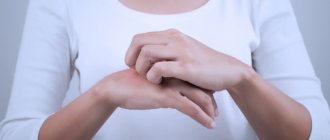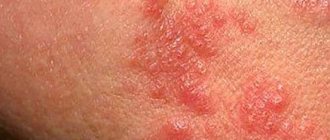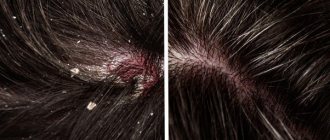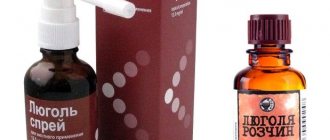Atopic dermatitis in children is a chronic, recurrent inflammatory skin disease with an immune mechanism. As a result of hypersensitivity reactions to various antigens (food products, pneumoallergens, bacterial proteins), a number of inflammatory factors are released in genetically predisposed children.
This results in eczematous lesions, which consist of edema and microvesicles, leading to itching, irritation, scratching and inflammatory lesions, symmetrical, varying in appearance and location depending on the age of the child. It is often associated with asthma, rhinitis and food allergies.
Types of atopic dermatitis
Experts identify the following types of disease:
- Infant (from birth to 2 years). The first signs appear in the first months of life. The rash is localized in the cheeks and forehead. This type of disease is popularly called diathesis. Affected areas become wet and swollen
- Children (from 2 to 12 years old). It worsens when the skin comes into contact with an irritant. It is characterized by excessive dryness and itching.
Depending on the pathogen, there are the following clinical and etiological options: food, fungal, tick-borne and pollen. A type of disease with secondary infection is also distinguished.
Reasons for development
Childhood atopic dermatitis is a public health problem in developed countries and has a prevalence of 10 to 20%. Within the same country, rates are higher in urban areas and among populations with higher standards of living. With age, the prevalence and intensity of the disease decrease. 60% of patients are diagnosed in the first year of life, mainly in the first six months, in 85% in the first 5 years and only in 10% after 7 years.
In 70-80% of patients it develops against the background of a hereditary predisposition. The genetic basis is combined with various immunological changes in the skin, which cause dysfunction of the protective barrier:
- mutations lead to the appearance of microcracks, transepidermal loss of moisture and pH imbalance;
- this facilitates the entry of environmental irritants, allergens (mites, food, pollen) that increase sensitivity, and pathogens such as Staphylococcus aureus.
These factors lead to cellular infiltration of the dermis and constant inflammation with an initial imbalance of lymphocytes that produce Ig E upon contact with allergens. Subclinical inflammation persists even beyond exacerbation
Main causes of the disease:
- Excessive dryness. Patients have a defect that prevents the skin from moisturizing. The situation is especially worse in winter due to the use of heaters and reduced indoor humidity. Frequent washing without subsequent moisturizing also dries.
- Stimulus. Various household chemicals and low-quality care products can cause burning, redness, itching or dryness.
- Emotional stress. Sheer disappointment, fear and anger are provocateurs to which the child’s skin reacts with itching and redness.
- Excessive sweating. If clothing is not appropriate for the weather, the skin performs the function of thermoregulation - it sweats, which leads to a worsening of the clinical picture.
Separately, infection with staphylococcus should be considered. In this case, outlined areas or vesicles with pus appear. The disease can be caused by herpes and fungus. In rare cases, pollen, dust mites and pets cause atopic dermatitis in very young children.
Atopic dermatitis: how to help your child
Authors : American Academy of Pediatrics
Atopic dermatitis (AD, eczema) is a chronic skin disease that is accompanied by dryness, redness and itching.
At what age does atopic dermatitis appear?
Atopic dermatitis is the most common skin disease seen by pediatric dermatologists. In 65% of young patients with this diagnosis, symptoms develop before the age of 1 year, in 90% - before the age of 5 years. Most children outgrow atopic dermatitis by the age of 4; for some, it only goes away in adolescence, but the skin remains dry and sensitive even after. In rare cases, atopic dermatitis remains for life. Parents should know how they can help with eczema and, if necessary, alleviate the child’s condition.
Atopic dermatitis usually occurs in children with a family history of eczema or other allergic conditions such as hay fever or asthma. Atopic dermatitis is not contagious.
Symptoms of atopic dermatitis
Because atopic dermatitis is a chronic skin disease, its symptoms may disappear and reappear. Periods of exacerbation (when symptoms intensify) alternate with periods of remission (when the skin condition improves or the symptoms completely disappear).
Symptoms of atopic dermatitis vary from child to child, but common symptoms include dry, red skin, itching and rash. The skin is so dry that sometimes even cracks can form on it.
Eczema can appear on any part of the body and even in several places at once.
- In infants, the rash usually occurs on the face and scalp.
- For preschoolers and children of primary school age - on the elbows and knees.
- In children of middle and high school age, the rash most often appears on the arms and legs.
How to avoid exacerbation of the disease?
To prevent atopic dermatitis from getting worse, follow the recommendations below.
- Use emollients (moisturizing creams or ointments). The child's skin must be moisturized, so the use of emollients should be part of the child's daily care.
- Choose unscented emollients. When purchasing a product, keep in mind that cream or ointment moisturizes the skin more effectively than lotion.
- After your bath, gently pat your skin dry with a towel and then apply emollient to damp skin.
- Apply moisturizer at least once a day, and more often if necessary.
- Avoid irritating substances and fabrics. If you or your child are sensitive to “irritating” fabrics or chemicals in skin care products:
- choose clothes made from soft natural fabrics, such as 100% cotton;
- use only sensitive skin care products, preferably unscented;
- limit your time in the shower or bath to 5–10 minutes, use water at room temperature, but never hot;
- choose hypoallergenic laundry detergents (without dyes or fragrances);
- Avoid frequent use of fabric softener.
- Make sure that the child does not comb the damaged areas , try to distract him from this. Scratches can worsen the condition of the skin, and there is a high risk of wound infection. Keep your child's nails short and without sharp edges.
- Allergies can be a cause of atopic dermatitis, so discuss this with your pediatrician . Some allergies, such as food allergies, pet dander allergies, dust allergies, or dust mite allergies (those that live in pillows, mattresses, and clothing), cause rashes and worsen skin conditions. If your child's atopic dermatitis is determined to be due to an allergy, avoid exposure to the allergen if possible.
- Ask your pediatrician about other reasons that can trigger an exacerbation of eczema (overheating, stress, etc.).
Treatment
Your pediatrician may prescribe medications to help your baby and improve his skin condition. The choice of medication will depend on the form of atopic dermatitis and the location of its lesions on the body. For atopic dermatitis, there are two ways to use medications. They can be:
- apply to the skin (topical application) in the form of a cream or ointment;
- taken orally (orally) in tablets or liquid form.
Before you give your child any medications, make sure you know exactly how to use them. Talk to your pediatrician if you have questions or concerns about how to use the medicine.
Over-the-counter medications
- Topical steroids (such as hydrocortisone ointment or cream) can relieve itchy skin and reduce inflammation. They help best with mild forms of atopic dermatitis.
- Topical antihistamines can provide quick relief from dry, itchy skin with minimal side effects. Some of these medications contain alcohol, which may cause a burning sensation.
- Oral antihistamines
Prescription medications
- Topical steroids are prescribed to reduce inflammation (redness and swelling) and itching. These effective and safe drugs are widely used to treat atopic dermatitis. If you do not use the drug as directed, side effects such as thinning skin, stretch marks, or acne may sometimes occur.
- Local immunomodulators (non-steroidal drugs) are used to reduce inflammation and itching. This is a new class of drugs, the effectiveness of which in children over 2 years of age exceeds 80%.
- Oral antihistamines can be quite effective in some cases.
- Oral antibiotics are prescribed if there is a secondary infection.
- Oral steroids are rarely prescribed to children because they are unsafe. After discontinuation of such drugs, exacerbations often occur.
Remember:
Atopic dermatitis is a chronic skin disease whose symptoms may disappear and reappear. The solution to this problem is up to you, your child and your pediatrician. If you follow these recommendations and your child's skin does not improve, consult your doctor.
Source
published 04/12/2014 10:47 updated 17/01/2018 — Skin diseases, Dermatology
Symptoms of atopic dermatitis in children
Clinical manifestations form the basis of diagnosis, as there are no specific microscopic or laboratory changes.
Main manifestations depending on age:
- Babies. Signs of the disease appear from the second month, with erythematous exanthema, with a large exudative component that forms scabs and is localized on the cheeks, forehead, and also affects the nasolabial triangle. Distributes symmetrically to the scalp, front part of the body and limbs. The diaper area is usually left untouched.
- Children from 2 to 12 years old. Skin manifestations may begin at this stage or recur after a free interval of up to 2-3 years. Localization is typical on the elbow bends and popliteal folds. There is a characteristic itching in the affected area. Other typical sites include the thighs, wrists, eyelids, hands and fingers.
- Teenagers. Papular and lichen-like lesions predominate in this phase based on intense xerosis. It is predominantly localized in large folds, on the upper third of the arms and back, the back of the arms and legs, and on the fingers.
Symptoms that should alert parents: dry skin, small cracks in the crease of the earlobe, fingers and toes, redness and peeling on the back of the toes or mouth. Hyperkeratosis, which gives the appearance of goosebumps, is localized on the buttocks, deltoid region, outer thighs and torso. Erythematous plaques on the cheeks, dark circles under the eyes and pallor may occur.
Possible complications
Complications of atopic dermatitis in children:
- Asthma and allergic rhinitis (hay fever). Sometimes eczema precedes these diseases. More than half of young children with atopic dermatitis develop asthma and allergic rhinitis by age 13.
- Chronic itching and flaking. This disorder can cause the affected area to change color and become thicker.
- Skin infections. Infection increases the risk of contracting bacteria and viruses, such as the herpes simplex virus.
- Allergic contact dermatitis. This disease often occurs in patients with atopic dermatitis.
- Sleep problems. The characteristic severe itching can lead to insomnia.
Diagnosis of atopic dermatitis
A test for general and specific Ig E is prescribed to determine the cause of skin inflammation. The doctor makes the diagnosis by examining the affected areas and taking a medical history. The specialist may also use patch tests or other tests to rule out other skin conditions.
If parents suspect that a certain food was the cause of a rash on the child’s body, then they need to inform the doctor about this and ask about the possibility of identifying potential food allergens. In this case, a diet is prescribed for treatment.
What is atopy
The term “atopy” refers to an abnormal reaction of the body to an allergen, which generally explains the nature of the disease.
With the development of atopy, there is an overproduction of IgE antibodies, which are responsible for the appearance of an allergic reaction. AD belongs to the same group of diseases as urticaria, hay fever and bronchial asthma. The pathology is immune-dependent, since the main factor in its development is a mutation in genes. Specifically, we are talking about the genes encoding filaggrin. This structural protein is located in the skin and is involved in the formation of the skin barrier, preventing water loss and the entry of allergens and microorganisms. For this reason, the pathology is inherited from one of the parents, most often from the mother.
Interestingly, atopic dermatitis was essentially known back in ancient times. In those days, this disease was called “idiosyncrasy.” That is, the name reflected the mechanism of development of the pathology - as an increased reaction to an allergen - but did not explain its etiology.
The term “atopy” was first used in 1922 to define the body’s increased sensitivity to external factors.
Treatment of atopic dermatitis in children
Atopic dermatitis can be permanent. You may need to try multiple treatments over several months or years to control the disease. Even if treatment is successful, signs and symptoms may reappear.
Early detection of the disease allows timely treatment to begin. That is why, when primary symptoms appear, you need to contact an allergist-immunologist or dermatologist.
If regular moisturizing and other personal hygiene measures do not help, your doctor may suggest medication:
- Corticosteroid ointments. Relieve itching and help restore skin. Apply them according to the instructions after moisturizing the skin to avoid adverse reactions.
- Calcineurin inhibitors. Ointments are prescribed for ages 2 years and older. Affect the immune system. Avoid intense sunlight when using these products.
- Medicines to fight infection. Antibacterial cream is prescribed for bacterial infections, open sores or cracks. Oral antibacterial drugs may also be prescribed.
- Medicines to control inflammation. In severe cases, your doctor may prescribe oral corticosteroids.
Effective and intensive treatment for severe forms of the disease involves wrapping the affected area with topical corticosteroids and moist dressings. The procedure is performed under the supervision of medical professionals.
Phototherapy (light therapy) is prescribed to children whose condition does not improve with local treatment. The procedure involves exposure to a controlled amount of natural sunlight alone or in combination with medications.
Although effective, long-term phototherapy has detrimental effects, such as premature aging and an increased risk of cancer. For these reasons, phototherapy is not often used in young children and is not performed in infants.
Disease prevention
The following recommendations are aimed at preventing episodes of illness and minimizing the effects of dryness after bathing:
- Moisturize your skin at least twice a day. Use creams, ointments, or lotions that lock in moisture. Select one or more products suitable for your child.
- Try to identify and avoid triggers that make the condition worse. Prevent stress, negative effects of pollen dust. Dress your child according to the season to prevent him from sweating.
- Infants and children may experience flare-ups when consuming certain foods, such as eggs, milk, soy, and wheat. Talk to your doctor about how to identify possible food allergens.
- Use only mild soap. Choose products with a neutral pH level. Antibacterial soap removes natural oils and dries out the skin.
Water procedures should not exceed 10-15 minutes. After your bath, dry your skin gently with a soft towel and apply a moisturizer.
Skin care
To relieve itching and prevent infection of the affected skin, you need to properly care for your skin:
- It’s better not to take a shower, but to take a cool bath for about 10 minutes; use medicated bathing products with a soft base that cleanse but do not dry the skin;
- moisturizing and softening – the skin should not be dry to prevent flaking and cracking; regularly apply a moisturizer recommended by a dermatologist;
- Do not let your child scratch the affected areas to avoid infection - apply anti-itching products to the atopic areas.
Cream or gel relieves discomfort during an exacerbation and allows you to sleep, eat, and play peacefully. Apply the drug to cleansed skin, treat atopic lesions and the areas around them. Do not exceed the recommended dosage and frequency of use.







